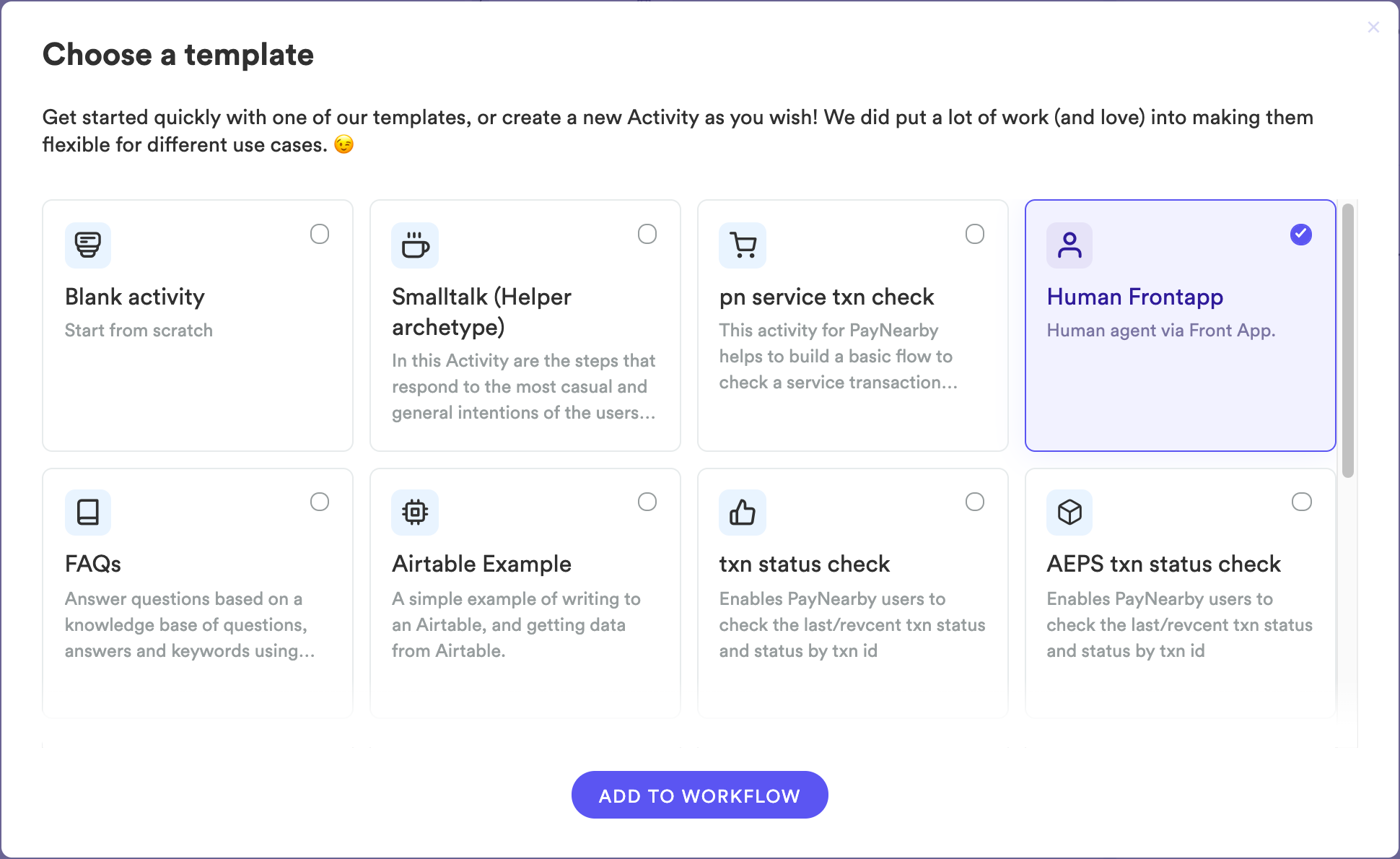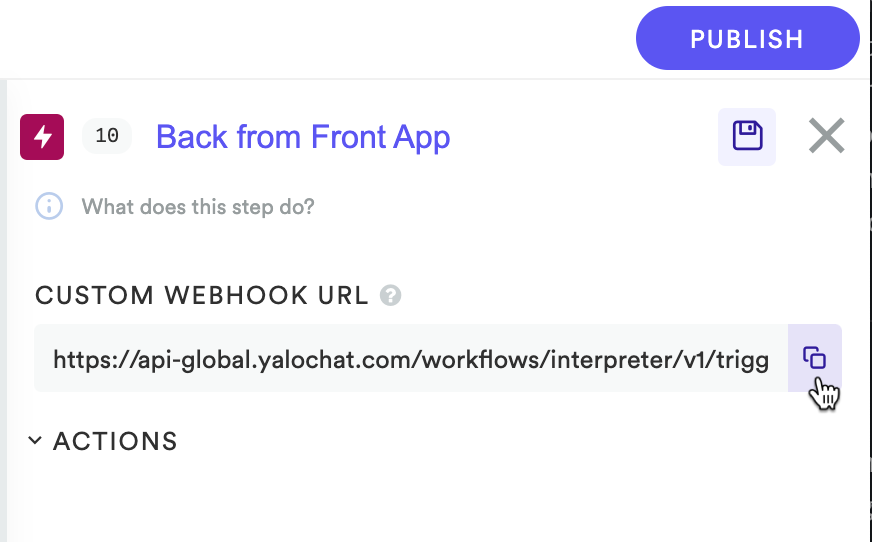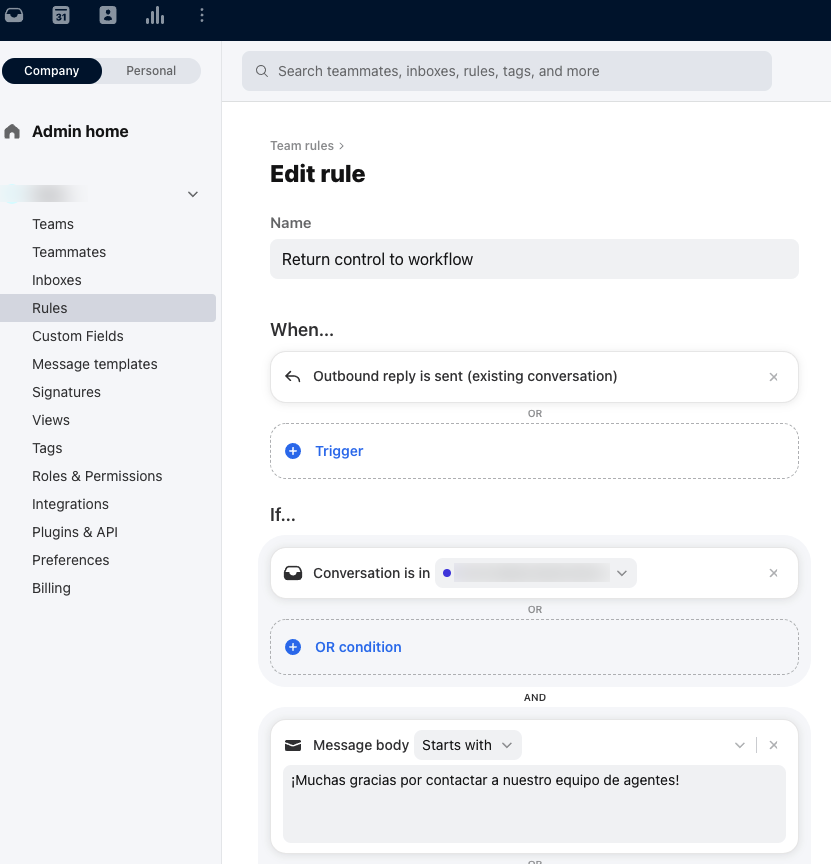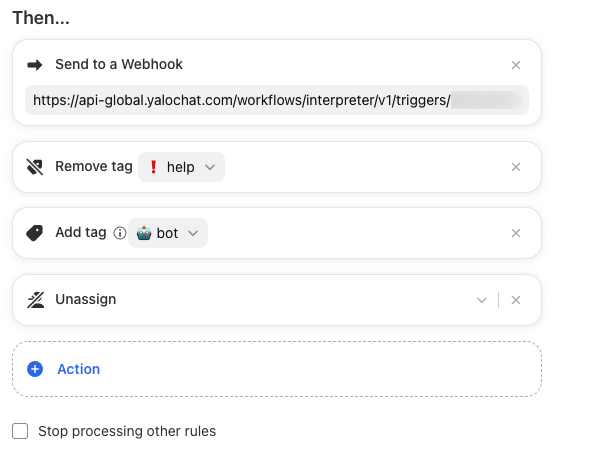Transfer a Conversation to a Human-Agent
During an automated, intelligent workflow-driven conversation, it may be necessary or desired to bring in a live, human agent for the user to chat with. There are many reasons to bring a live human agent into the conversation, such as:
- The user asks for a live person
- The endpoint of the conversational Flow is an 'Assisted Sale'
- The user is having trouble finding the answer to their question
Example
A user contacts your company's WhatsApp number and is looking for information about returning a product.
From the menu, the user selects FAQs and then asks how to make a return. Either the answer doesn't exist in the FAQ, or the user does not understand the answer and asks to speak with a person. At this point, the Flow notifies a human agent via Front that a user requires assistance. The Flow is 'paused' while the agent chats with the user and explains the return process. Once the user's question has been satisfactorily answered, the agent asks the user to take a satisfaction survey and, upon approval, hands the user back to the Flow for a CSAT survey.
User Flow
- User asks to speak with a person
- The Flow passes the request to Front
- A live agent picks up the request and chats with the user on WhatsApp
- Once the user's issue is resolved, the live agent passes the user back to the automated workflow
Requirements
Front
- An Active Front instance.
- An Active flow in your Front instance.
- A Front API Token specifically for the flow.
Yalo Studio
- Human FrontApp Activity Template added to your workflow
- Webhook URL for Front
Implementing the Human-Agent Transfer Activity
Building this activity is straightforward but does require modification of code, and there are several pieces of information to collect beforehand.
Before you start
Collect the following information from your instance of Front:
- Bot Agent - the email address assigned to Front for this kind of activity
- Bot Tag - this is typical 'bot,' but please confirm that there is not another tag that should be used
- Front App API Authorization Token - permits for the workflow to send messages to Front via their API
- Message - the message to be sent to Front. Typically this is something like "User is waiting for an agent" and should indicate that a user is requesting a live person
- source - for WhatsApp, this is always 'custom'
Front is Managed By Yalo
If your Front instance is provided and managed by Yalo, you will need to file a support ticket to get the above information and to have an API authorization token generated.
Step One: Add the Human Frontapp activity to your workflow
- Click the New Activity button
- Find the Human Frontapp activity in the Activity Gallery and select it
- Click 'Add to Flow'

The Studio Activity Template Gallery displays a grid of available activity templates for your workflow.
Step Two: Configure the activity to work with your instance of Front App
- Open the new activity by selecting it in the Activities sidebar
- Select the Human Start step and expand the code view, it will look something like this:
-- Connect to Front App
-- Config object sent to Front App with API request
body = {
bot = {
nextState = {
script = {
options = {
botAgent = "ADD EMAIL ADDRESS HERE", -- email address configured for Front Inbox
botTag = "bot", -- bot tag, this is usually the default
frontAppToken = "ADD FRONTAPP TOKEN HERE", -- an auth token is needed to connect to FrontApp
humanTag = "help", -- tag for the user request type
message = "User is waiting for an agent.", -- message to be sent to FrontApp
source = "custom", -- custom is the default for WhatsApp, this should not need to be changed
userId = Context.get("userId"), -- the user's WhatsApp number
}
}
}
}
}
body = JSON.encode(body) --encodes body as a JSON
result = Invoke.cloudFunction("frontapp-scripts-human-mode", body) -- call to the lambda script that handles the connection to Front App
botAgent and frontAppToken are the critical variables here.
- botAgent is the email address associated with your Front inbox
- frontAppToken is the Front App API authorization token
Once you have updated the Code Action, close the code window and save your work
The second activity step, Human Session, does not require any configuration
The third step, Back from Front App, does not require any configuration. However, we do need the webhook URL it provides to configure Front to hand the conversation back to the workflow after the live agent session ends. Make sure to copy this URL.

Custom Webhook URL from Yalo Studio for Front App integration
The final activity step, Human End also does not require changes but you may want to update the message copy or button options to be more tailored to your workflow.
At this point it is a good idea to make sure that all steps in your workflow are saved. After Front is configured in the next step, you will be able to test the activity to ensure it works properly.
Step Three: Configure Front to Send the User Back to the Flow
If Front Is Managed by Yalo
If your Front instance is provided and managed by Yalo, you will need to file a support ticket to get the following rule created.
The last requirement we have is to configure Front for returning the user to the workflow chat in WhatsApp. This step requires that we create a rule in Front that determines when the live agent portion of the conversation is over and what to do at that point (send the user back to the workflow).
Rules in Front are fairly simple, we define a WHEN clause, an IF clause, and a THEN clause.
- WHEN determines when the rule should be evaluated
- IF determines whether the rule evaluates to true
- THEN defines what happens when the rule is true
For this activity we would define the following in our Rule:
- Run the rule when an outbound (to the user) message is sent
- If the conversation is in the correct inbox and the message starts with a specific text for a goodbye message
- Then do the following:
- Send to a webhook (the webhook URL from our workflow)
- Remove tag 'help'
- Add tag 'bot'
- Unassign (this unassigns the conversation from the agent)
Here's what that might look like in Front

Front App Rule Conditions for Human Agent Activity

Front App Rule Actions for Human Agent Activity
Considerations
This guide describes only how to configure the Human Frontapp activity. You will need to decide how users will engage with this activity. Is it through a specific menu option? Is it at the end of a failed FAQ? Should they be able to speak to an agent whenever they ask for one?
Updated over 2 years ago
